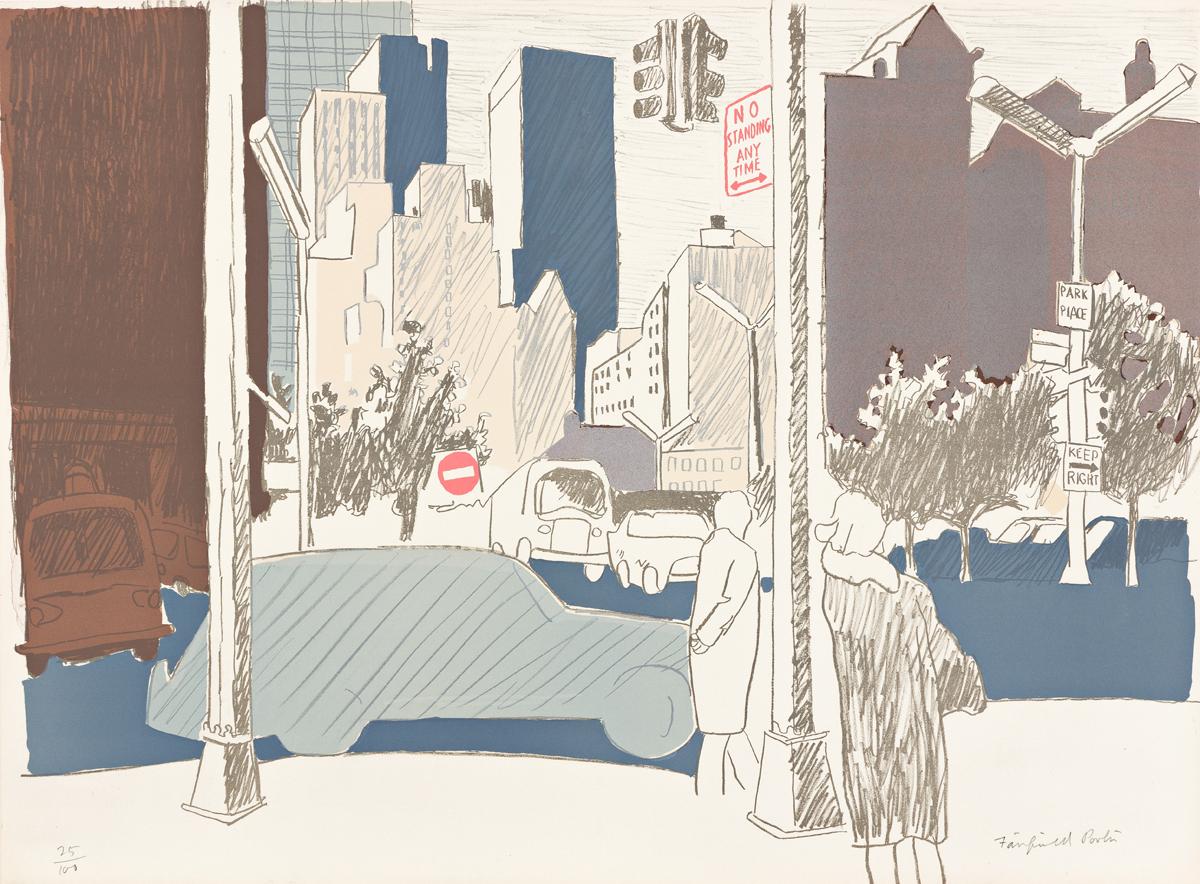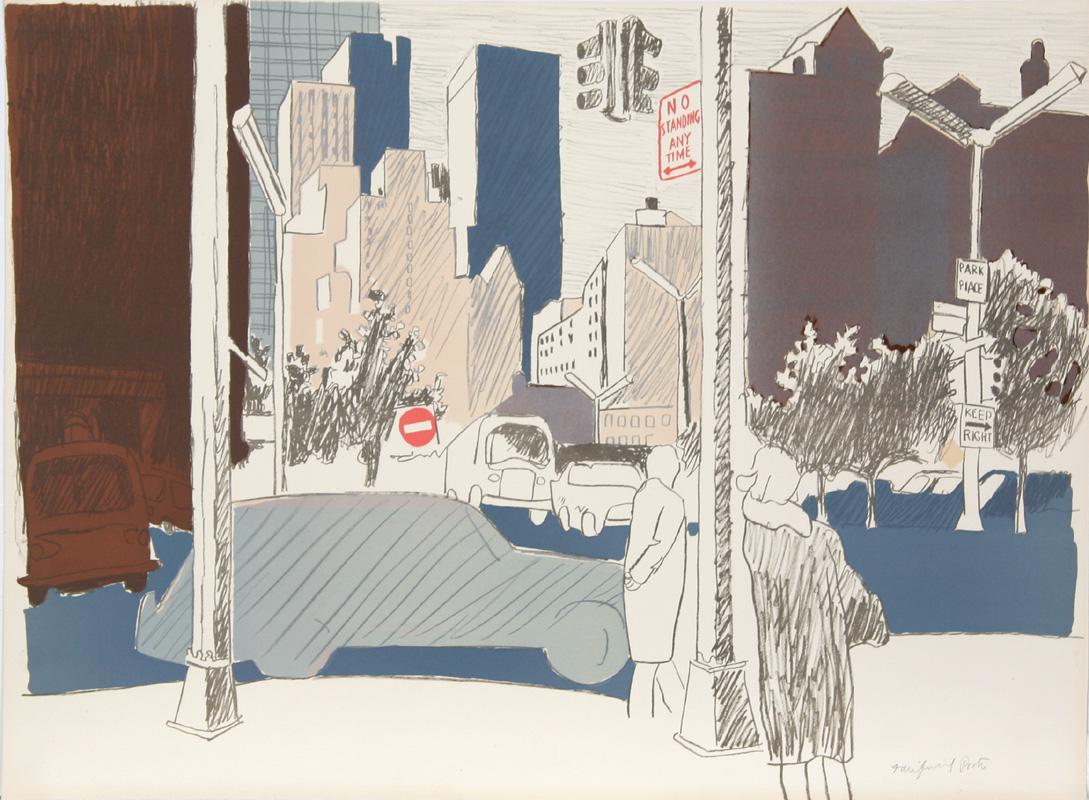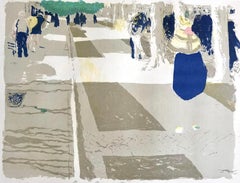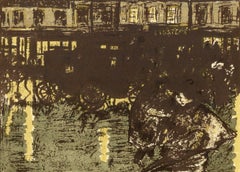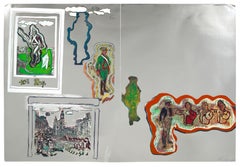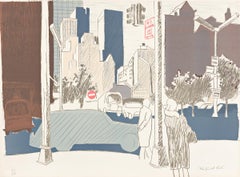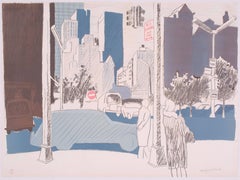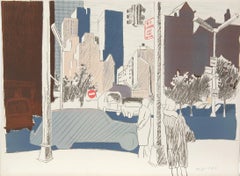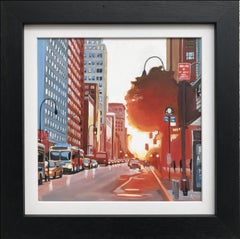Items Similar to New York City Street Scene (L.18), Fairfield Porter
Want more images or videos?
Request additional images or videos from the seller
1 of 8
Fairfield PorterNew York City Street Scene (L.18), Fairfield Porter1969
1969
$2,396
$2,99520% Off
£1,777.92
£2,222.4120% Off
€2,071.04
€2,588.8020% Off
CA$3,335.25
CA$4,169.0620% Off
A$3,714.10
A$4,642.6320% Off
CHF 1,932.98
CHF 2,416.2320% Off
MX$45,794.42
MX$57,243.0220% Off
NOK 24,618.03
NOK 30,772.5420% Off
SEK 23,138.57
SEK 28,923.2120% Off
DKK 15,452.52
DKK 19,315.6520% Off
Shipping
Retrieving quote...The 1stDibs Promise:
Authenticity Guarantee,
Money-Back Guarantee,
24-Hour Cancellation
About the Item
Artist: Fairfield Porter (1907-1975)
Title: Street Scene (L.18)
Year: 1969
Medium: Lithograph on Arches paper
Edition: 69/100, plus proofs
Size: 22.25 x 30 inches
Condition: Excellent
Inscription: Signed and numbered by the artist
Notes: Published by Brooke Alexander, Inc., and printed by Mourlot.
FAIRFIELD PORTER (1907-1975) Fairfield Porter was an intelligent and enigmatic artists because he was a realist in an era dominated byAbstract Expressionism. He was good friends with many of the Abstract Expressionists, especially Willem de Kooning, He was also an art critic who wrote for "Art News" and "The Nation". Porter was also a conservationist, activist, and polemicist who opposed nuclear arms, pesticides, urban sprawl, and the Vietnam War. Porter’s art and art criticism combine to form a coherent and independent interpretation of art and art history. Fairfield Porter was born in Winnetka, Illinois, a small suburb north of Chicago. His paternal grandmother had owned land in Chicago that eventually became its Loop area, which provided the Porter family with the financial means for a comfortable lifestyle. Porter's parents were literate and well educated. His father, James Porter, was an architect who designed the family’s Greek Revival home, and his mother, Ruth, was a politically progressive woman who supported the suffrage movement and racial equality. Porter’s family traveled extensively during his youth, so that by the time he was a teenager, he had been exposed to a wide variety of arts and ideas. In 1924, Porter, like his father and grandfather before him, attended Harvard University. It was there that he received his first art education, although it had little direct impact on him. Following his graduation in 1928, Porter moved to New York and began taking classes at the Art Students League. Porter was eager to study there with various teachers who were also professional artists, such as Boardman Robinson and Thomas Hart Benton. However, Porter was soon disappointed by the curriculum at the League, which emphasized life drawing to the exclusion of painting. Porter later recalled that he abandoned the League because, "Nobody taught painting there. I mean you could paint if you wanted to. But they didn't know how to paint. There wasn’t anybody in the League who knew how to paint. . . . I don’t think anybody in America knew how to paint in oils at that time (interview with Paul Cummings, June 6, 1968, Archives of American Art, Washington, D.C., as quoted in John T. Spike, Fairfield Porter: An American Classic [1992], p. 34). In the 1930s, struggling to get his professional painting career off the ground, Porter tried his hand at progressive, social arts, painting murals and designing magazine covers for the Socialist party and other leftist organizations. He also made his first foray into art criticism, contributing an essay on mural painting to "Arise" in 1935. Despite Porter’s many connections to, and sympathies with, various left-wing political factions in New York, he never identified himself as belonging to any one group. This was to be a recurring theme in Porter’s life, in which he circulated freely among various social and intellectual groups and movements without ever committing himself completely to any one of them. In 1938, Porter saw an exhibition of paintings and prints by Pierre Bonnard and Edouard Vuillard at the Art Institute of Chicago, an eye-opening experience which changed the course of his style of painting. Although the effects of seeing these pictures didn't fully materialize until later in his career, Porter cited Vuillard as the single greatest influence upon his own work. He recalled: "Another reason I paint the way I do is that in 1938 we were living in Chicago and in the Art Institute in Chicago there was an exhibition of Vuillard and Bonnard, both of them. I had never seen so many Vuillards before or maybe so many Bonnards before. And I looked at the Vuillards and thought — maybe it was just a sort of revelation of the obvious and why does one think of doing anything else when it’s so natural to do this (Cummings interview, as quoted in Spike, op. cit., p. 62)." Porter understood his own work as an extension of the sensual and representational achievements of Vuillard, recording impressions at hand with a confident use of color and light. He eschewed traditional techniques of contour and form, and the inherent lack of spontaneity that follows, that he associated with artists such as Thomas Hart Benton. Thus, in his pictures, he strove for a freshness and vitality similar to the abstract painters of his generation, but they are grounded in a less theoretical, more realistic approach. Porter’s oil paintings are immediate, sensual impressions of the world immediately before him, unconstrained by any adherence to a particular theory. Like many of the abstract painters, Porter appreciated the materiality of paint and its effects on the surface of the canvas. He painted with Maroger’s Medium, an additive to oil paints that makes them more fluid and freely brushed onto the canvas. Although Maroger’s was available commercially, Porter always preferred to make his own. He wanted a rich surface texture that recall not only Bonnard and Vuillard, but also Diego Velázquez, whom Porter admired. Porter’s output during the 1940s was uneven, and he ultimately destroyed many of his works from this period once his career began to reach its full swing. It wasn’t until the early 1950s that his career began to take off. This can be explained, in part, by the fact that Porter’s son, John, born in 1934, suffered from some form of mental retardation similar to autism, which took many frustrating years to diagnose. In a 1958 letter to his friend, Arthur Giardelli, Porter explained: John was sick from birth with a mysterious illness that was never quite understood. . . . No psychiatrists or doctors seemed to know anything definite about him, and the result on me was that I really did nothing for about the first ten years of his life but try to somehow help him. This was a most frustrating experience, because I was trying to solve something for which there was no solution. Then it was only after that, that is after deciding, on advice from a psychiatrist, to send him to a foster home, that I began to have a career or life of my own" (as quoted in Spike, op. cit., p. 132). Introduced by his friend, Willem de Kooning, Porter began to exhibit at the Tibor de Nagy Gallery in New York, which was known primarily as a venue for Abstract Expressionist painting. Porter’s work, largely landscape pictures of the areas of Southampton, New York, where he and his family lived, eventually gathered a following of critics and collectors who otherwise had interest in non-objective painting. It was during this time that the roots of Porter’s career as a critic also began to grow. He took issue with contemporary art critics, including Clement Greenberg, George L. K. Morris, Wyndham Lewis, and other proponents of Abstract Expressionism, whom he saw as “manifesto critics” who imposed personal theories of art upon the work they reviewed. Porter felt about criticism as he did about his art: that it should be as free of dogmatic adherence to theory as possible, and that art should be considered on its own merits. Porter crossed swords with these writers on many occasions, and he often wrote to the publications that printed their essays to object to their points of view. However, he left the intellectual sparring out of his own essays. Porter’s criticism is thoughtful and sensitive, and exhibits his encyclopedic grasp of art history and a depth and breadth of knowledge about contemporary art that few others shared. He wrote for "Art News" from 1951 to 1959, and "The Nation" from 1959 to 1961, when he stopped writing regular columns so that he could devote himself fully to painting. (For a thorough reading of Porter’s art criticism, see Rackstraw Downes, ed., Fairfield Porter: Art In Its Own Terms, Selected Criticism 1935-1975 [1979].) Porter did his best work during the last fifteen years of his life. His style loosened somewhat, and he incorporated more abstract forms and colors and recorded a freer and more immediate impression of his subjects. In his lifelong pursuit of realistic, non-abstract subjects, however, Porter was far ahead of his time, particularly in painting portraits of his family and friends, a genre that wasn’t taken seriously by the art world until years later.
- Creator:Fairfield Porter (1907-1975, American)
- Creation Year:1969
- Dimensions:Height: 22.25 in (56.52 cm)Width: 30 in (76.2 cm)
- Medium:
- Movement & Style:
- Period:
- Condition:
- Gallery Location:Fairfield, CT
- Reference Number:1stDibs: LU1342113568412
About the Seller
5.0
Vetted Professional Seller
Every seller passes strict standards for authenticity and reliability
Established in 2002
1stDibs seller since 2020
886 sales on 1stDibs
Typical response time: 1 hour
- ShippingRetrieving quote...Shipping from: Fairfield, CT
- Return Policy
Authenticity Guarantee
In the unlikely event there’s an issue with an item’s authenticity, contact us within 1 year for a full refund. DetailsMoney-Back Guarantee
If your item is not as described, is damaged in transit, or does not arrive, contact us within 7 days for a full refund. Details24-Hour Cancellation
You have a 24-hour grace period in which to reconsider your purchase, with no questions asked.Vetted Professional Sellers
Our world-class sellers must adhere to strict standards for service and quality, maintaining the integrity of our listings.Price-Match Guarantee
If you find that a seller listed the same item for a lower price elsewhere, we’ll match it.Trusted Global Delivery
Our best-in-class carrier network provides specialized shipping options worldwide, including custom delivery.More From This Seller
View AllVuillard, L´Avenue, L'œuvre gravé de Vuillard (after)
By Edouard Vuillard
Located in Fairfield, CT
Medium: Lithograph on grand vélin Renage paper
Year: 1948
Paper Size: 9.5 x 12.375 inches; image size: 9.05 x 11.81 inches
Inscription: Unsigned and unnumbered, as issued
Notes: From...
Category
1940s Post-Impressionist Figurative Prints
Materials
Lithograph
$716 Sale Price
20% Off
Bonnard, Les Boulevards, Bonnard Lithographe (after)
By Pierre Bonnard
Located in Fairfield, CT
Medium: Lithograph on grand vélin Renage filigrané paper.
Year: 1952
Paper Size: 9.5 x 12.5 inches; image size: 7.48 x 9.45 inches
Inscription: Unsigned and unnumbered, as issued
Not...
Category
1950s Post-Impressionist Figurative Prints
Materials
Lithograph
$716 Sale Price
20% Off
Bonnard, Rue le soir sous la pluie, Bonnard Lithographe (after)
By Pierre Bonnard
Located in Fairfield, CT
Medium: Lithograph on grand vélin Renage filigrané paper.
Year: 1952
Paper Size: 9.5 x 12.5 inches; image size: 7.48 x 10.24 inches
Inscription: Unsigned and unnumbered, as issued
No...
Category
1950s Post-Impressionist Figurative Prints
Materials
Lithograph
$716 Sale Price
20% Off
40th Regiment (Boston Massacre), Larry Rivers
By Larry Rivers
Located in Fairfield, CT
Artist: Larry Rivers (1923-2002)
Title: 40th Regiment (Boston Massacre)
Year: 1970
Medium: Silkscreen and collage on wove paper
Edition: 25/150, plus p...
Category
1970s Abstract Expressionist Abstract Prints
Materials
Screen, Mixed Media
$3,600 Sale Price
20% Off
Bonnard, Rue vue d´en haut, Bonnard Lithographe (after)
By Pierre Bonnard
Located in Fairfield, CT
Medium: Lithograph on grand vélin Renage filigrané paper.
Year: 1952
Paper Size: 12.5 x 9.5 inches; image size: 10.63 x 6.3 inches
Inscription: Unsigned and unnumbered, as issued
Not...
Category
1950s Post-Impressionist Figurative Prints
Materials
Lithograph
$716 Sale Price
20% Off
Bonnard, Place Clichy, Bonnard Lithographe (after)
By Pierre Bonnard
Located in Fairfield, CT
Medium: Lithograph on grand vélin Renage filigrané paper.
Year: 1952
Paper Size: 9.5 x 12.5 inches; image size: 9.5 x 12.5 inches
Inscription: Signed in the plate and unnumbered, as ...
Category
1950s Post-Impressionist Figurative Prints
Materials
Lithograph
$716 Sale Price
20% Off
You May Also Like
Street Scene
By Fairfield Porter
Located in New York, NY
Porter's first color lithograph. A very good impression on Arches with strong colors. Signed and numbered 25/100 in pencil. Printed by Mourlot, New York. Published by Brooke Alexande...
Category
1960s Abstract Expressionist Landscape Prints
Materials
Color, Lithograph
STREET SCENE
By Fairfield Porter
Located in Portland, ME
Porter, Fairfield. STREET SCENE. Lithograph in colors, 1969. Edition of 100, signed in pencil and numbered 84/100. 22 1/4 x 30 inches, handsomely framed ...
Category
1960s American Modern Prints and Multiples
Materials
Lithograph
New York City, Lithograph by Fairfield Porter
By Fairfield Porter
Located in Long Island City, NY
Artist: Fairfield Porter, American (1907 - 1975)
Title: Untitled (NYC)
Year: circa 1970
Medium: Lithograph on Arches, signed and numbered in pencil
Edition: 100
Size: 22 in. x 30 in....
Category
1970s American Impressionist Landscape Prints
Materials
Lithograph
New York Street Scene Urban Landscape Painting from British Artist Collection
By Angela Wakefield
Located in Preston, GB
New York City Street Scene - an Original Painting by British Urban Landscape Artist Angela Wakefield.
At measures 12 x 12 inches
Frame measures 16 x 16 inches
The character of New...
Category
2010s American Impressionist Landscape Paintings
Materials
Oil, Paint, Acrylic, Board
NEW YORK Broadway Street Scene FEMALE American Modernist Impressionist Painter
By Jane Wilson
Located in New York, NY
Up for sale is a New York City Street, Broadway by Jane Wilson (1924-2015). Jane wilson was an important female Abstract Expressionists painter. She has been exhibited in many museum...
Category
1960s Abstract Expressionist Landscape Paintings
Materials
Oil
Varick Street New York City, Painting, Oil on MDF Panel
By Howard Danelowitz
Located in Yardley, PA
Varick Street in New York City is viewed at dusk. The sun is seen having the same light intensity as the street lamps.
:: Painting :: Contemporary :: ...
Category
2010s Contemporary Paintings
Materials
Oil
